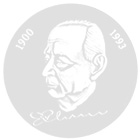For the invention of metal oxide thin film transistors for display applications
Active-Matrix flat panel displays use thin film transistors for selection and driving of the electro-optical media such as liquid crystals or organic light emitting diodes placed in the various pixels. For direct view displays, this requires the deposition and structuring of the metals, dielectrics and semiconductors used in the thin film transistor on up to square meter sized areas. A cost-efficient deposition of thus large monocrystalline semiconductors is impossible, so that only polycrystalline or amorphous semiconductors can be used.
The imperfections and dislocations of these semiconductors usually result in significantly deteriorated electronic properties. In the case of the previously preferred elementary semiconductor silicon, this results in one (polycrystalline) to three (amorphous) orders of magnitude lower carrier mobility and thus similarly reduced current driving capability and switching speed. In comparison to polycrystalline silicon, amorphous silicon enables a significantly simpler and thus cheaper manufacturing process combined with a significantly better large area homogeneity resulting from the missing crystal boundaries. As it is still meeting the requirements for voltage controlled electro-optical materials (e.g., liquid crystals) at Full-HD TV resolution, it had been the preferred material for the realization of direct view TVs for some time. Lacking better alternatives, the extremely well performing but also expensive polycrystalline silicon has been used for current driven electro-optical materials (e.g., organic light emitting diodes) which high pixel resolution such as in mobile phones, although it vastly exceeds the respective requirements.
The new material class of metal oxide compound semiconductors firstly proposed by the awardee in 1997 exhibits extremely interesting properties, which his group was able to demonstrate for the application in thin film transistors in a more than 8000 times cited publication the year 2004. As the conduction band properties of metal oxide semiconductors are predominantly defined by the spherical s-orbitals of the metal ions, the loss of carrier mobility experienced in the transition to amorphous materials is significantly smaller than in the case of the covalent bonds of silicon. Furthermore, amorphous metal oxide semiconductors can be deposited with an extremely simple physical vapor deposition process, leading to an extremely competitive process even in comparison to amorphous silicon. The commonly used amorphous indium gallium zinc oxide exhibits 1.5 order of magnitude higher carrier mobility than amorphous silicon and thus gives access to the intermediate range that is more adapted to display applications. Due to the desirable combination of good current driving capability and simple processing even on large areas, all since 2013 worldwide sold OLED TVs use metal oxide thin film transistors for driving the pixels.
Besides the already mentioned advantages, metal oxide semiconductors exhibit a comparatively large band gap of more than 3 eV. Even the most energetic blue photons have a lower energy and are thus not absorbed in metal oxide semiconductors, which enables the realization of optically transparent circuits. Furthermore, the large band gap leads to three orders of magnitude lower off currents in comparison to amorphous silicon, which permits a significant reduction of the display refresh rate for static or predominantly static image contents. The related significant reduction of energy consumption is the reason for applying metal oxide thin film transistors in the newest generation of the Apple Watch and other mobile devices. Furthermore, the low off current in combination with the possibility for low temperature processing also motivates numerous research efforts outside of the display technology in the area of 3D integration of future highly integrated circuits.
This years award winner, Prof. Hideo Hosono has not only given the decisive impulse for all these developments but also for more than twenty years been instrumental for the development of various other materials such as a new kind of high temperature superconductor. Numerous prizes and awards such as the Japan Prize (2016) and the Van Hippel Award of the Material Research Society (2018) are documenting the worldwide recognition of Prof. Hosono´s work.
The Eduard Rhein Foundation honors Prof. Hideo Hosono as an internationally renowned pioneer of metal oxide semiconductors, who has created the foundation for new applications in the display technology as well as in the general microelectronics.
Prof. Dr.-Ing. Norbert Fruehauf
